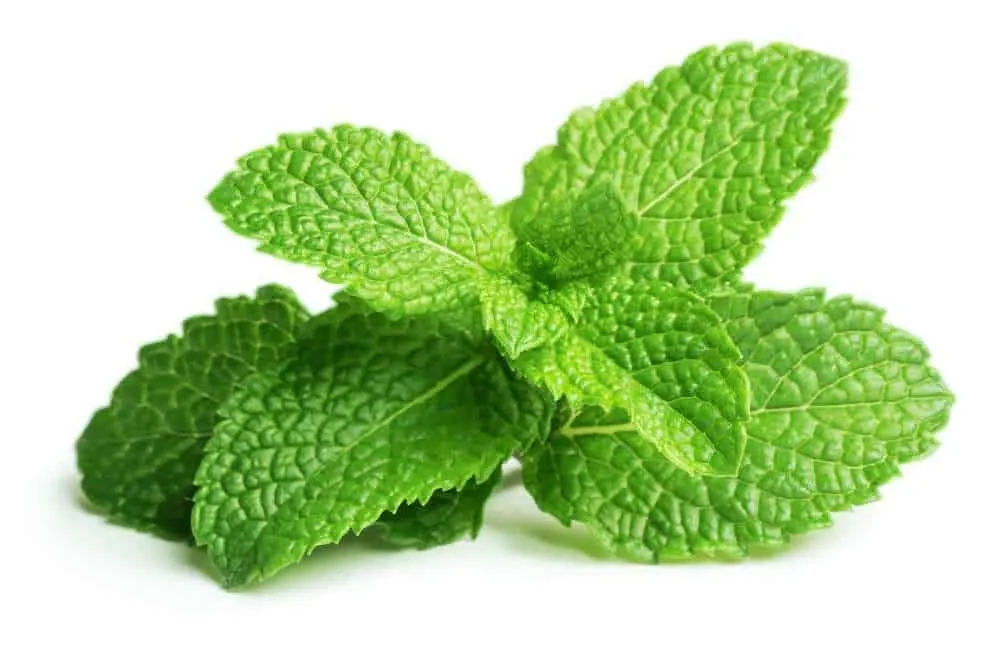Winter is coming, my friends, and we all know that winter is a peppermint season.
Everything seems to be mint flavored around holidays. Candy cane, candy cane latte, mint cookies, mint chocolate, oh well, none of those are suitable for your pet, but the point is that all that peppermint fragrance can motivate you to try introducing mint into your pup’s diet.
Or maybe your pupper suffers from bad breath, and you think that mint can save the day and eliminate that nasty problem. You are not far from the truth.
However, you need to stop and question yourself is serving a mint to my dog a safe thing to do? Can dogs eat mint? Maybe the even better question is – is mint poisonous for dogs?
Today I am going to teach you how to introduce the mint into your dog’s diet.

What Is Mint And Can Dogs Eat It?
Mint is a hybrid plant that is an end result of mixing the spearmint plant and a water mint plant. All three species as well their extracts can be consumed by a dog but only in small amounts. So yes, dogs can eat mint but with a lot of precautions.
However, it is recommended that you do not use mint extracts since they can be harmful to your pets and lead to liver and kidney problems, an upset stomach, and put their digestive system off-balance. This means they will experience vomiting, diarrhea, and nausea.
On the other hand, fresh mint leaves may soothe your dog’s nausea and upset stomach if used in the right quantities. Also, spearmint will work wonders if your dog suffers from bad breath. Since mint is very fragrant and aromatic, you can use it as a strong flea repellant.
The mint family is large and diverse; it is safe to use varieties like lavender mint, apple mint, and even pineapple mint in dogs’ diets. Make sure never to use Pennyroyal mint since this type is non-culinary and toxic for both people and dogs.

Benefits Of Mint In Dogs Diet
There are a lot of health benefits of mint when it is used correctly.
The problem is that we humans often assume that things that are healthy for us are healthy for our pets as well, so we end up harming them without even knowing it. Anyhow when mint is used in smaller amounts, your dog can experience some of these benefits:
- Fresh mint is rich in Vitamins A and C, which will enhance their immune system, make their bones stronger, provide healthy skin and boost vision
- Mint is full of minerals like calcium, copper, iron, magnesium, phosphorus, folate, potassium, and zinc. These minerals provide well-balanced nutrition and support your dog’s immune system
- Mint is a natural source of dietary fibers, and we all know that fibers are a great help in maintaining healthy digestion. Fresh mint is great in relieving symptoms of inflammatory bowel disease and reducing gas
- The antioxidants from mint help in protecting a dog’s body from free-radicals and oxidation in the cells
- Essential oils in fresh mint leave in smaller amounts will soothe an upset stomach and relieve nausea or diarrhea
- Fresh mint contains rosmarinic acid, which is responsible for relieving symptoms associated with seasonal allergies. Also, menthol is a natural decongestant, so if your dog has respiratory problems or a hard time breaking through mucus and phlegm, mint will help solve these inconveniences
- Mint can be of great help for dogs that have gone through chemotherapy or radiation treatments since mint leaves help in reducing the side effects of these treatments
- Humans use mint cause of its natural antiviral, antimicrobial, antibacterial, and antifungal benefits, which can all help freshen up your breath and maintain your gums healthy, well all this can be applied to your dog as well

What Is The Best Way To Feed Your Dog With Mint?
The easiest way to add mint to your pet’s diet is to sprinkle their regular food with a few leaves of fresh or dried mint.
Don’t do that more than once a day; in fact, do not feed them mint every day. Like with all new food, ingredients start with very small amounts and watch for signs; if all goes well, gradually increase the amount. Remember, dogs should not take more than two or three mint leaves per day.
You can as well make some homemade dog treats and enhance their flavor with fresh mint. I love baking treats for my tail wager, so in the next few rows, I will share my favorite mint dog cookie recipe, and I hope your pooch will be crazy about them as much as mine is.
Doggy Mint Cookies
I always use fresh peppermint leaves when creating this healthy snack for my buddy. These treats are a great and healthy snack that will help improve your pet’s breath.
Ingredients you will need to bake these goodies:
- 2½ cups of oats
- ½ cup of finely chopped fresh parsley
- ½ cup finely chopped fresh peppermint
- One large egg
- If you want to make the cookies more flavorful or your dog does not tolerate eggs well, you can use ¼ cup of unsweetened applesauce
- ¼ cup and one teaspoon of water
- Three tablespoons of extra virgin unrefined coconut oil
Follow these instructions:
- Preheat your oven to 325°F
- Blend oats in the blender until it turns into finely grounded flour.
- In a large bowl, mix coconut oil, water, egg or applesauce, mint, and parsley
- Stir in oat flour and combine it well
- Knead the dough for some time before turning it out onto a flour-covered surface
- Flatten the dough to be thick as you prefer by using a rolling pin
- Use a cookie cutter or knife to cut out treats in dimensions you prefer
- Place the cookies on a parchment-lined or non-stick cookie sheet and make sure you make some room between them
- Bake the cookies for about 35-40 minutes
- Take them out from the oven and allow them to cool completely
- Store the cookies in an airtight container
What About Mint Essential Oil?
In case you do not want to feed fresh mint leaves and instead, want to try to add mint essential oil, you must be very careful since some mint essential oils like Pennyroyal and peppermint are toxic to dogs! The problem is that when the essential oil is applied topically or orally, it gets absorbed in the body very quickly and ends up in the dog’s liver, where it gets broken down.
That is why you should think twice when considering using essential oil over fresh mint leaves. The only advice I can give you is to discuss this with your veterinarian and see what he will recommend to you.
How To Recognize Pennyroyal Poisoning?
Pennyroyal mint can be toxic to dogs and humans if they eat it! But pennyroyal mint is used to make some flea powders and deodorize sprays since it is much more aromatic than any other mint species.
Pennyroyal essential oil can potentially cause severe poisoning that may result in death if applied directly to your dog’s skin, especially in larger amounts. The compound called pulegone is the one responsible for complications since it can cause liver damage.
Symptoms of pennyroyal poisoning are:
- Lethargy
- Nose bleeds
- Diarrhea
- Vomiting
- Heavy breathing
If you have used this essential oil near your dog or they’ve ingested it, somehow monitor them and look for the symptoms stated above and call your vet immediately.

Summary
Peppermint is a superfood that can significantly enhance overall health for both humans and dogs. But as you may notice, not all types of mint are safe for consumption. Some mint species are suitable for dogs, and some are very poisonous to dogs. Always make sure to feed your dog with a species that you are absolutely sure is culinary graded and not wintergreen.
Many dog owners love to supplement their babies by using essential oils; if that is the case with you, take good care of the dosages you are using. Keep in mind that you need to dilute essential oil before giving them to your dog.
A great way to introduce mint into your pup’s diet is through doggy treats. So don’t be lazy and bake a fresh batch of homemade doggy cookies flavored with mint and enjoy minty fresh thank you kisses afterward. You are welcome!
Learn More: What Can Dogs Eat? A Comprehensive List Of Dog-safe Foods


